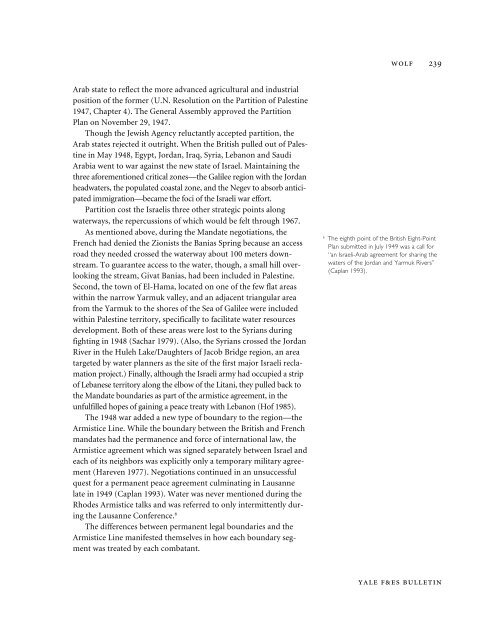Hydrostrategic Decisionmaking and the Arab ... - Yale University
Hydrostrategic Decisionmaking and the Arab ... - Yale University
Hydrostrategic Decisionmaking and the Arab ... - Yale University
Create successful ePaper yourself
Turn your PDF publications into a flip-book with our unique Google optimized e-Paper software.
WOLF 239<strong>Arab</strong> state to reflect <strong>the</strong> more advanced agricultural <strong>and</strong> industrialposition of <strong>the</strong> former (U.N. Resolution on <strong>the</strong> Partition of Palestine1947, Chapter 4). The General Assembly approved <strong>the</strong> PartitionPlan on November 29, 1947.Though <strong>the</strong> Jewish Agency reluctantly accepted partition, <strong>the</strong><strong>Arab</strong> states rejected it outright. When <strong>the</strong> British pulled out of Palestinein May 1948, Egypt, Jordan, Iraq, Syria, Lebanon <strong>and</strong> Saudi<strong>Arab</strong>ia went to war against <strong>the</strong> new state of Israel. Maintaining <strong>the</strong>three aforementioned critical zones—<strong>the</strong> Galilee region with <strong>the</strong> Jordanheadwaters, <strong>the</strong> populated coastal zone, <strong>and</strong> <strong>the</strong> Negev to absorb anticipatedimmigration—became <strong>the</strong> foci of <strong>the</strong> Israeli war effort.Partition cost <strong>the</strong> Israelis three o<strong>the</strong>r strategic points alongwaterways, <strong>the</strong> repercussions of which would be felt through 1967.As mentioned above, during <strong>the</strong> M<strong>and</strong>ate negotiations, <strong>the</strong>French had denied <strong>the</strong> Zionists <strong>the</strong> Banias Spring because an accessroad <strong>the</strong>y needed crossed <strong>the</strong> waterway about 100 meters downstream.To guarantee access to <strong>the</strong> water, though, a small hill overlooking<strong>the</strong> stream, Givat Banias, had been included in Palestine.Second, <strong>the</strong> town of El-Hama, located on one of <strong>the</strong> few flat areaswithin <strong>the</strong> narrow Yarmuk valley, <strong>and</strong> an adjacent triangular areafrom <strong>the</strong> Yarmuk to <strong>the</strong> shores of <strong>the</strong> Sea of Galilee were includedwithin Palestine territory, specifically to facilitate water resourcesdevelopment. Both of <strong>the</strong>se areas were lost to <strong>the</strong> Syrians duringfighting in 1948 (Sachar 1979). (Also, <strong>the</strong> Syrians crossed <strong>the</strong> JordanRiver in <strong>the</strong> Huleh Lake/Daughters of Jacob Bridge region, an areatargeted by water planners as <strong>the</strong> site of <strong>the</strong> first major Israeli reclamationproject.) Finally, although <strong>the</strong> Israeli army had occupied a stripof Lebanese territory along <strong>the</strong> elbow of <strong>the</strong> Litani, <strong>the</strong>y pulled back to<strong>the</strong> M<strong>and</strong>ate boundaries as part of <strong>the</strong> armistice agreement, in <strong>the</strong>unfulfilled hopes of gaining a peace treaty with Lebanon (Hof 1985).The 1948 war added a new type of boundary to <strong>the</strong> region—<strong>the</strong>Armistice Line. While <strong>the</strong> boundary between <strong>the</strong> British <strong>and</strong> Frenchm<strong>and</strong>ates had <strong>the</strong> permanence <strong>and</strong> force of international law, <strong>the</strong>Armistice agreement which was signed separately between Israel <strong>and</strong>each of its neighbors was explicitly only a temporary military agreement(Hareven 1977). Negotiations continued in an unsuccessfulquest for a permanent peace agreement culminating in Lausannelate in 1949 (Caplan 1993). Water was never mentioned during <strong>the</strong>Rhodes Armistice talks <strong>and</strong> was referred to only intermittently during<strong>the</strong> Lausanne Conference. 6The differences between permanent legal boundaries <strong>and</strong> <strong>the</strong>Armistice Line manifested <strong>the</strong>mselves in how each boundary segmentwas treated by each combatant.6The eighth point of <strong>the</strong> British Eight-PointPlan submitted in July 1949 was a call for“an Israeli-<strong>Arab</strong> agreement for sharing <strong>the</strong>waters of <strong>the</strong> Jordan <strong>and</strong> Yarmuk Rivers”(Caplan 1993).YALE F&ES BULLETIN
















